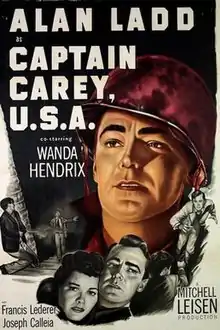| Captain Carey, U.S.A. | |
|---|---|
 Theatrical release poster | |
| Directed by | Mitchell Leisen |
| Screenplay by | Robert Thoeren |
| Based on | After Midnight by Martha Albrand |
| Produced by | Richard Maibaum |
| Starring | Alan Ladd Wanda Hendrix Francis Lederer |
| Cinematography | John F. Seitz |
| Edited by | Alma Macrorie |
| Music by | Hugo Friedhofer |
| Color process | Black and white |
Production company | Paramount Pictures |
| Distributed by | Paramount Pictures |
Release date |
|
Running time | 83 minutes |
| Country | United States |
| Language | English |
| Box office | $1,625,000[1] |
Captain Carey, U.S.A. is a 1949 American crime film noir directed by Mitchell Leisen and starring Alan Ladd and Wanda Hendrix. An American returns to post–World War II Italy to bring a traitor to justice.
The film was based on the novel After Midnight by Martha Albrand. It was filmed under the title O.S.S. and then the title After Midnight.[2]
The theme song, "Mona Lisa", was performed in the film by Charlie Spivak with Tommy Lynn. Jay Livingston and Ray Evans won the Academy Award for Best Original Song. It was a #1 hit for Nat King Cole in 1950.
Plot
A group of agents of the U.S. Office of Strategic Services (a forerunner of the Central Intelligence Agency) is sent to German-occupied Italy during World War II to knock out the German-held Italian railroad system. In accomplishing this mission, most of them are killed because of an inside betrayal.
After the war, one of the survivors, Captain Webster Carey (Alan Ladd), resolves to find the traitor. Captain Carey returns to Orta, near Milan, to find out who betrayed his World War II O.S.S. team and caused the deaths of several villagers. Much to his surprise, his old love Giulia (Wanda Hendrix), whom he thought dead at the hands of the Nazis, is alive and married to a powerful Italian nobleman, Barone Rocco de Greffi (Francis Lederer). The villagers are unfriendly, but Carey persists in his clandestine efforts to flush out the traitor, who turns out to be de Greffi.
Cast
- Alan Ladd as Captain Webster Carey
- Wanda Hendrix as Baronessa Giulia de Greffi
- Francis Lederer as Barone Rocco de Greffi
- Joseph Calleia as Dr. Lunati
- Celia Lovsky as Countess Francesca de Cresci
- Richard Avonde as Count Carlo de Cresci
- Frank Puglia as Luigi
- Luis Alberni as Sandro
- Angela Clarke as Serafina
- Roland Winters as Manfredo Acuto
- Paul Lees as Frank
- Jane Nigh as Nancy
- Russ Tamblyn as Pietro (as Rusty Tamblyn)
- Virginia Farmer as Angelina
- David Leonard as Blind Musician
- Ernő Verebes as Detective
- Ray Walker as Mr. Simmons
- Argentina Brunetti as Villager (uncredited)
- Gino Corrado as Villager (uncredited)
Production
The film was based on the serial Dishonored. Jonathan Latimer was originally announced as screenwriter and the stars were to be Ray Milland and Alida Valli, with the title to be After Midnight.[3]
Then Alan Ladd was given the lead role, and Lewis Allen meant to direct.[4][5] Eventually Mitchell Leisen was given the job of directing.[6]
Filming started 3 January 1949.[7]
It was released in England in late 1949, but not shown in the U.S. until 1950, thus making it eligible for the 1950 Academy Awards.
Accolades
The film is recognized by American Film Institute in these lists:
- 2004: AFI's 100 Years...100 Songs:
Notes
The fictional film seems to recall real places and real events: the setting in Orta San Giulio, Lake Orta, Villa Castelnuovo and the Major of the United States of America Army William H. Holohan who on the night of the 6th December 1944, Commander of a secret mission behind enemy lines in charge of coordinating allied supplies to the partisan formations, with a secret refuge in a difficult to reach Villa and with a suitcase with a lot of money destined for the partisan formations, mysteriously disappeared in San Maurizio d ' Opaglio on Lake Orta during a Nazi attack; his brother who in the following years investigates, listens to witnesses, writes letters and one of these arrives in the hands of a Carabiniere who in turn investigates, collects elements until the confession of a murder by poisoning and with gunshots from fire, and the discovery of the body 5 years later, by order of the Partisan Chief Vincenzo "Cino" Moscatelli, as admitted by himself to Edward Bennett Williams and FBI later when he was Senator of the Italian Communist Party.
References
- ↑ "Top Grosses of 1950". Variety. January 3, 1951. p. 58.
- ↑ Peter J. Levinson (2005), September in the Rain, ISBN 9781589791633
- ↑ Brady, Thomas F. (1 October 1948). "Paramount Seeks Valli for Picture: Studio Would Team Actress With Ray Milland in 'After Midnight,' Albrand Novel". New York Times. p. 31. Retrieved January 12, 2020.
- ↑ Brady, Thomas F. (17 November 1948). "Metro Acquires 'The Judas Kiss': Studio Buys Irving Revetch's Story as Possible Vehicle for Heflin or Taylor". New York Times. p. 33. Retrieved January 12, 2020.
- ↑ Schallert, Edwin (18 November 1948). "Otto Preminger to Direct Tierney, Conte as Team; Barker Scouts Zoo Stars". Los Angeles Times. p. B9.
- ↑ Schallert, Edwin (27 November 1948). "Cowan to Map Marxes' Life Story While Abroad; Hatcher, Wyatt Deals Set". Los Angeles Times. p. 7.
- ↑ Schallert, Edwin (6 December 1948). "Unique Musical Feature Slated by W. R. Frank; Sweden Seeking 'Names'". Los Angeles Times. p. 27.
- ↑ "AFI's 100 Years...100 Songs Nominees" (PDF). Archived from the original (PDF) on 2015-04-17. Retrieved 2016-07-30.